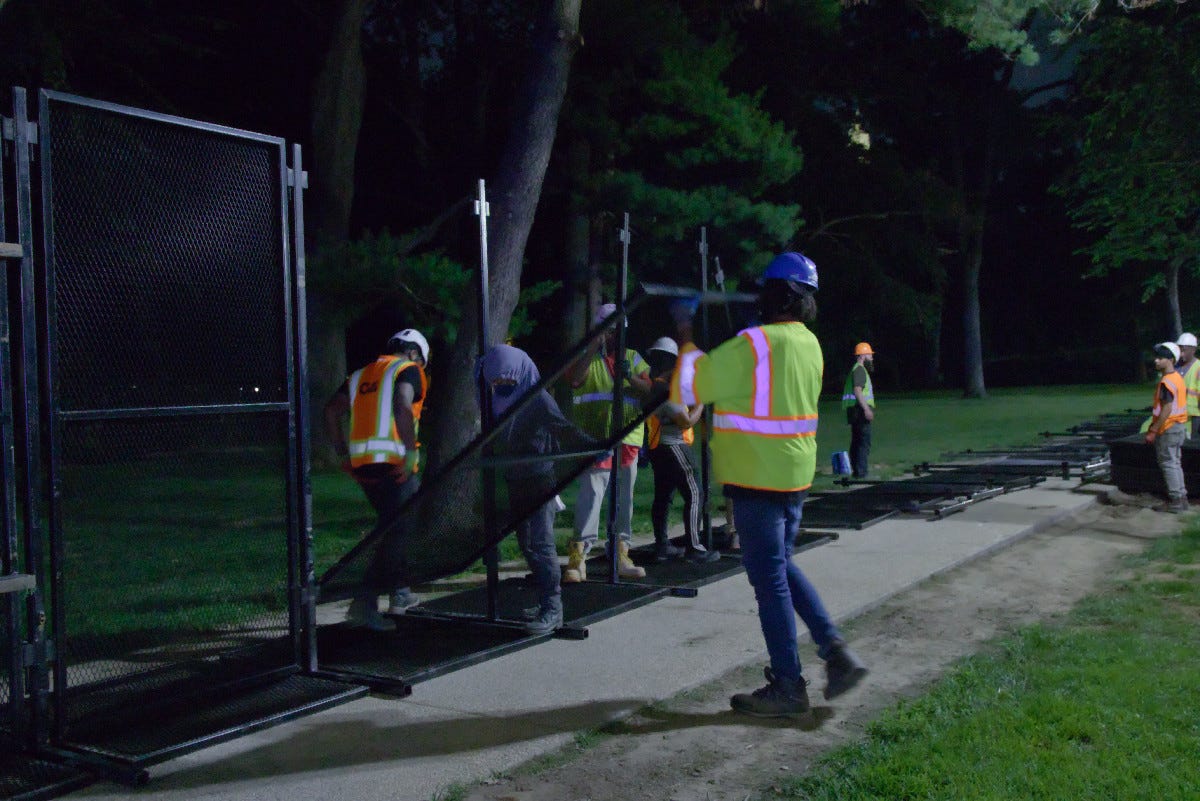Immigrant laborers being used overnight to install preparations for Trump's parade.
Meanwhile, supervisors express uncertainly whether fencing is intended to keep people in, or keep them out.

The sight of military hardware on the ground in the nation’s capital is unusual. Something tells me there hasn’t been this many weapons systems here since the Civil War saw the city serve as the headquarters for Union command. Meanwhile, in Los Angeles Army soldiers have been deployed against the local population, with Marines currently undergoing training to do the same.
People in LA have been protesting President Trump’s brutal immigration policies and a recent attempt at a blitzkrieg against local suspected illegal immigrants. Given that Trump’s harsh policies have swept up American citizens, and have deported lawful immigrants and even tourists attempting to leave the country, it’s not far fetched to say that the administration’s war in southern California is against Hispanics more so than immigrants.
Boots on the ground in LA. Tanks in Washington DC. Immigration round ups in LA. Immigrant laborers in DC. That’s what I discovered on Tank Watch Wednesday night.
After observing several tanks being unloaded on Independence Avenue, and moved into a holding area down West Basin Dr, I began a foot trek back toward 14th street. Along the way I passed night crews installing fencing along the parade route, coming across a crew of immigrant laborers waiting for a supply delivery. In the darkness I might have scarcely seen more than silhouettes. But their voices pointed to their identity, as they conversed in Spanish in undeniably Latin accents. These were no native Anglo speakers.

Any possibility of being dual native Anglo-Spanish speakers was quickly put to rest when I tried to take a photograph of them. One of the men changed to English to make a request. “You send me picture? You send me to my phone!” A second man offered a few English words of agreement. Undeniably Latin accents. The first man then continued with, “Hey, Washington Post!,” in celebration of 15 hoped-for seconds of fame.
With the darkness making it impossible to capture a meaningful photograph, the man informed me they would be back Thursday night, still working on the preparations, if I wanted to try again.
Continuing my walk I opted to stay along the outside of fencing portions already installed. I passed a group of three supervisors on the opposite side of the barrier, overhearing a peculiar conversation. As they were strategizing their plans to finish the job they debated whether the purpose was to keep people inside the fence, or to keep them outside the fence.
“The goal isn’t to keep people from getting inside here, it’s to keep them inside, right?”
“Is it? I don’t know. I think we need to keep people from coming inside here.”
“No, I think you need to keep people from getting over there.”
Given that the fencing was surrounding the Mall, and that it was being constructed in the middle of the Mall (along with helicopters already in place), its purpose is certainly ambiguous. Fencing has also been installed surrounding most (but not all) of Lafayette Square. In all of these places, entry points continue to allow people into these areas, for now. Fencing around Lafayette Square has been used several times in the past few years, to prevent bad actors from causing destruction there. The reflecting pool itself has been fenced off during large events, such as Fourth of July celebrations, to similarly ward off mischief. But this wouldn’t explain installing a barrier that walls in everything in the reflecting pool’s and Washington Monument’s general vicinity between Independence and Constitution.



